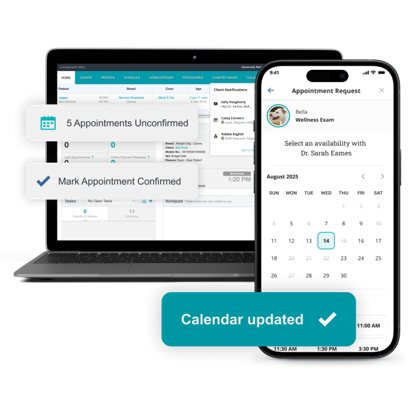Unlocking Peak Productivity: Best Practices for Veterinary Team Scheduling

Effective team member utilization is critical to veterinary practice success. Each veterinary hospital position plays a vital role in operations, and team members need the cooperation and help of others to do their job. A well-scheduled, appropriately trained, and engaged team can significantly enhance productivity and improve efficiency, patient care, and client satisfaction.
Appropriate veterinary team scheduling and utilization can help the practice overcome staff shortages, ensuring adequate coverage without overburdening team members. However, your team’s best scheduling strategy will likely vary from those that work for others. To help you unlock peak productivity, review our tips for optimizing veterinary team scheduling and utilization.
1. Revamp veterinary team scheduling
Veterinary professionals are in high demand and many hospitals regularly operate below their ideal staffing threshold. Practices often struggle to find and hire qualified team members. They may also lose team members who become overworked and overwhelmed trying to keep up without an adequate support team. Assessing and adjusting veterinary team scheduling practices can help the practice operate at peak efficiency by making the most of available resources. These tips can be your starting point:
- Identify peak times — Use historical data from your veterinary practice management software to identify busy times. This may require a deep dive, as busy times can vary seasonally, around school schedule shifts, and during holidays. Look for trends that indicate busy times during the day, week, weekend, month, or year. Then, focus on ensuring adequate staffing during those times.
- Stagger shifts — Staggered shifts can help ensure enough team members are clocked in at any given time. Overlap shifts during the busiest times and stagger breaks accordingly. Staggering can help you offer flexibility—an essential attribute veterinary professionals want in their jobs. Use short shifts, long shifts, split shifts, late arrivals, or early departures to accommodate the team’s personal needs. Ensure you focus on fairness to prevent resentment.
- Adjust staffing ratios — The number of support staff per veterinarian depends on each veterinarian’s practice preferences. The faster your veterinarian moves from room to room, the more team members you need. Overstaffing creates inefficiencies, but understaffing can limit production potential. Consider adjusting team schedules based on the veterinarians’ schedules, but only after determining their preferences.
- Cross-train team members — Cross-training team members creates schedule flexibility and eases the burden when some team members are sick or on vacation. Consult team members to assess their interest in learning other positions and keep an open mind—training assistants in a reception role is not the only possibility.
- Use scheduling software — A veterinary team scheduling software program allows for easy visualization and manipulation of the schedule for quicker adjustments. The best scheduling platforms assist by evaluating shift needs based on position and skill level.
2. Empower veterinary team members
Providing veterinary team members with tools, training, and authority to make decisions empowers them to excel in their roles. Empowered, well-educated team members will take the initiative to accomplish tasks without first checking with a superior. Micromanaging can undermine this initiative and prevent team members from using their entire skill set. Encourage autonomy by setting standard protocols for various situations and delegating tasks to team members based on their strengths and goals. Invest in ongoing training to reinforce team member strengths or interests or to fill knowledge gaps that are causing reduced job performance.
3. Boost veterinary team communication and collaboration
Effective communication and collaboration are essential for a well-functioning veterinary team. Team members working closely together must have mutual trust and respect to work efficiently. Helping team members develop this relationship ensures their workflows during shifts together are seamless. Some ways to boost communication and collaboration include regular team meetings, outings, community events, and digital team communication tools (e.g., Slack).
Optimizing veterinary team scheduling is an ongoing process that requires careful assessment, planning, training, communication, and re-assessment. Then, you can determine staffing ratios and team member roles and responsibilities that meet clinic and client demands. Implementing new scheduling strategies can ensure that your veterinary practice operates at peak efficiency while maintaining a positive and productive work culture.




